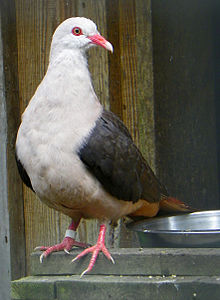 The pink pigeon (Nesoenas mayeri) is a species of pigeon in the family Columbidae endemic to Mauritius. The pink pigeons became nearly extinct in the 1990s and is still rare.
The pink pigeon (Nesoenas mayeri) is a species of pigeon in the family Columbidae endemic to Mauritius. The pink pigeons became nearly extinct in the 1990s and is still rare.This large pigeon has a light pink body and usually brown wings. Its bright-colored bill is moderately long and has a hooked tip.
The species is currently classified as endangered. Due to habitat destruction and introduced predators, the population had diminished to only 10 in 1991, but captive breeding and reintroduction has resulted in a population of about 450 in the wild in 2011.













